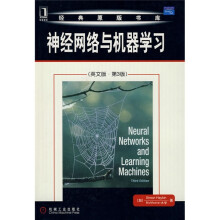Preface
Acknowledgements
Abbreviations and Symbols
GLOSSARY
Introduction
1 Whatis aNeuralNetwork?
2 The Human Brain
3 Models of a Neuron
4 Neural Networks Viewed As Dirccted Graphs
5 Feedback
6 Network Architecturns
7 Knowledge Representation
8 Learning Processes
9 Learninglbks
10 Concluding Remarks
Notes and Rcferences
Chapter 1 Rosenblatts Perceptrou
1.1 Introduction
1.2 Perceptron
1.3 1he Pcrceptron Convergence Theorem
1.4 Relation Between the Perceptron and Bayes Classifier for a Gaussian Environment
1.5 Computer Experiment:Pattern Classification
1.6 The Batch Perceptron Algorithm
1.7 Summary and Discussion
Notes and Refercnces
Problems
Chapter 2 Model Building through Regression
2.1 Introduction 68
2.2 Linear Regression Model:Preliminary Considerafions
2.3 Maximum a Posteriori Estimation ofthe ParameterVector
2.4 Relationship Between Regularized Least-Squares Estimation and MAP Estimation
2.5 Computer Experiment:Pattern Classification
2.6 The Minimum.Description-Length Principle
2.7 Rnite Sample—Size Considerations
2.8 The Instrumental,variables Method
2 9 Summary and Discussion
Notes and References
Problems
Chapter 3 The Least—Mean-Square Algorithm
3.1 Introduction
3.2 Filtering Structure of the LMS Algorithm
3.3 Unconstrained optimization:a Review
3.4 ThC Wiener FiIter
3.5 ne Least.Mean.Square Algorithm
3.6 Markov Model Portraying the Deviation of the LMS Algorithm from the Wiener Filter
3.7 The Langevin Equation:Characterization ofBrownian Motion
3.8 Kushner’S Direct.Averaging Method
3.9 Statistical LMS Learning Iheory for Sinail Learning—Rate Parameter
3.10 Computer Experiment I:Linear PTediction
3.11 Computer Experiment II:Pattern Classification
3.12 Virtucs and Limitations of the LMS AIgorithm
3.13 Learning.Rate Annealing Schedules
3.14 Summary and Discussion
Notes and Refefences
Problems
Chapter 4 Multilayer Pereeptrons
4.1 IntroductlOn
4.2 Some Preliminaries
4.3 Batch Learning and on.Line Learning
4.4 The Back.Propagation Algorithm
4 5 XORProblem
4.6 Heuristics for Making the Back—Propagation Algorithm PerfoITn Better
4.7 Computer Experiment:Pattern Classification
4.8 Back Propagation and Differentiation
4.9 The Hessian and lIs Role 1n On-Line Learning
4.10 Optimal Annealing and Adaptive Control of the Learning Rate
4.11 Generalization
4.12 Approximations of Functions
4.13 Cross.Vjlidation
4.14 Complexity Regularization and Network Pruning
4.15 Virtues and Limitations of Back-Propagation Learning
4.16 Supervised Learning Viewed as an Optimization Problem
4.17 COUVOlutionaI Networks
4.18 Nonlinear Filtering
4.19 Small—Seale VerSus Large+Scale Learning Problems
4.20 Summary and Discussion
Notes and RCfcreilces
Problems
Chapter 5 Kernel Methods and Radial-Basis Function Networks
5.1 Intreduction
5.2 Cover’S Theorem on the Separability of Patterns
5.3 1he Interpolation Problem
5 4 Radial—Basis—Function Networks
5.5 K.Mcans Clustering
5.6 Recursive Least-Squares Estimation of the Weight Vector
5 7 Hybrid Learning Procedure for RBF Networks
5 8 Computer Experiment:Pattern Classification
5.9 Interpretations of the Gaussian Hidden Units
5.10 Kernel Regression and Its Relation to RBF Networks
5.11 Summary and Discussion
Notes and References
Problems
Chapter 6 Support Vector Machines
Chapter 7 Regularization Theory
Chapter 8 Prindpal-Components Aaalysis
Chapter 9 Self-Organizing Maps
Chapter 10 Information-Theoretic Learning Models
Chapter 11 Stochastic Methods Rooted in Statistical Mechanics
Chapter 12 Dynamic Programming
Chapter 13 Neurodynamics
Chapter 14 Bayseian Filtering for State Estimation ofDynamic Systems
Chaptel 15 Dynamlcaay Driven Recarrent Networks
Bibliography
Index

 缺书网
缺书网 扫码进群
扫码进群






